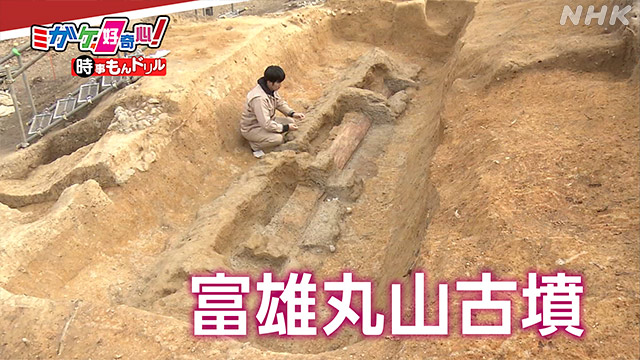discover!
What from the burial mounds of the "blank 4th century"?
March 2, 17:49
In January, there was an announcement that became a big topic.
At the Tomio Maruyama Burial Mound in Nara City, archaeologists found a mirror and a sword that surprised even archaeologists.
The Tomio Maruyama Burial Mound was built in a mysterious era called the "blank 4th century."
We asked an expert about this discovery in detail to see if it could be an opportunity to unravel the mystery.
The burial mounds of the "blank 4th century"
What kind of burial mound is the Tomio Maruyama burial mound, which was originally discovered?
A round-shaped burial mound located in the western part of Nara City.
With a diameter of around 110 meters, it is known as the largest round burial mound in Japan.
The surrounding area was developed for housing, but its importance was confirmed by excavations in the Showa period, and it has been preserved.
It was built in the latter half of the 4th century.
In fact, it is an era that is said to be "the blank four centuries".
According to Chinese history books, Himiko appears in the 3rd century, and the Five Kings of Wa appear in the 5th century.
However, there is no description of Japan in the 4th century, and it is shrouded in mystery.
For that reason alone, this discovery is attracting attention as a valuable resource for understanding the history of that time.
A national treasure discovery
What was discovered was the part called "Tsukuridashi" at the northeastern end of the burial mound.
A bronze mirror was unearthed here.
It is about 60 centimeters long and 30 centimeters wide, and has an unprecedented shield-like shape.
The reverse side is decorated with intricate patterns, such as an imaginary creature called a dragon.
For this reason, it was named the dragon pattern shield-shaped bronze mirror.
We asked Shinya Fukunaga, a professor at Osaka University who is familiar with the Kofun period, about this discovery.
Mr. Fukunaga
"Usually, when we think of a mirror, we immediately imagine a round shape. A shield-shaped mirror has never been found before, and archaeologists thought that such a thing existed. In addition, the main pattern of the dragon mirror is drawn on the back side in two places, on the top and bottom.If it is a normal mirror, There is only one similar pattern along the center of the mirror, which is very strange in terms of design.”
In addition, an iron sword with a wavy shape was also discovered in the burial mound.
With a length of over 2 meters and 30 centimeters, it is the longest serpentine sword of this era.
Mr. Fukunaga
``The handle is not very long, so it's almost impossible to swing it around, and it's probably better to think of it as a special sword rather than for actual combat. It doesn't let things come near, but the sword is a symbol of military power and can defeat evil things.
And he says that both the mirror and the sword are discoveries that show that there was a high level of technology.
Mr. Fukunaga
``The technology to make bronze ware, or the technology to make various iron tools, originally came from the continent. In many ways, the 4th century can be thought of as an era in which the formation of the Japanese archipelago rapidly progressed.”
The owner of the ancient tomb and the Yamato government
Then, I asked what kind of person it is thought to have been buried in the Tomio Maruyama ancient tomb where the mirror and sword were discovered.
Mr. Fukunaga:
“The Tomio Maruyama Kofun is the largest round burial mound in Japan, so to put it in modern terms, the most important people buried at the Tomio Maruyama Kofun are like the main cabinet members of the government. I think that the idea of
It is said that during this period, the Yamato government was formed by a coalition of influential people from various regions, centering on the king of the Yamato region.
Fukunaga believes that the kofun played a major role in that process.
Mr. Fukunaga
: “The burial mounds built by kings are supposed to be keyhole-shaped tumuli. It is thought that the Yamato government organized itself to attract new powers by giving newly emerging powers a rating that they could build a large, round burial mound. I think that is appropriate.
Rather than having the one who wins the battle in the end become the king, the idea of creating their own country based on some kind of agreement was quite strong among the people of the Japanese archipelago at that time. I think not.
I think it's a very rare case."
It is said that further investigations of the Tomio Maruyama Burial Mound and the discovery of additional burial goods may provide clues to the mystery of the void of the 4th century.
Mr. Fukunaga
: One of the expectations is that unexpectedly wonderful burial goods will be unearthed, but through the owner of the Tomio Maruyama Burial Mound, we will be able to approach truly major issues in Japanese history, such as the power structure of the Yamato government. I hope we can get some information."
Challenge the problem!
Finally, there is an entrance exam question related to the Kofun period.
In "Migake, curiosity!" of "Weekly Maruwaki News" (broadcast at 8:25 am on Sundays), we will delve into the news every week on topics such as current affairs presented in the entrance examination.
Let's think about "why?"
On the corner homepage, you can also review the past.
Please take a look at the link below.
https://www3.nhk.or.jp/news/special/maruwaka-migake/

